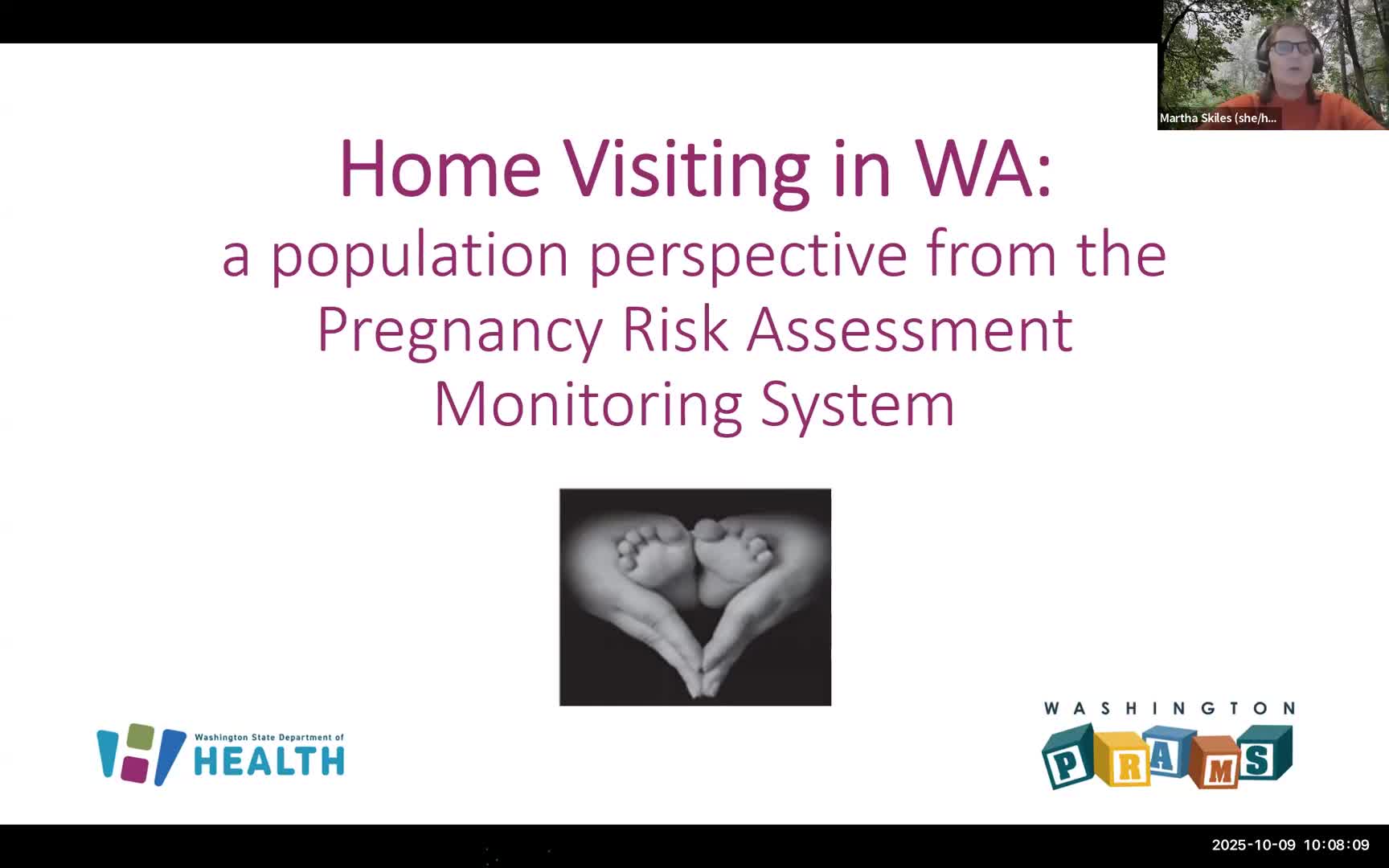PRAMS survey: about one‑in‑five birthing people report home‑visiting or doula support; 16% report home visiting services
October 20, 2025 | Children, Youth, and Families, Department of, State Agencies, Executive, Washington
This article was created by AI summarizing key points discussed. AI makes mistakes, so for full details and context, please refer to the video of the full meeting. Please report any errors so we can fix them. Report an error »

Martha Skiles of the Washington State Department of Health presented PRAMS (Pregnancy Risk Assessment Monitoring System) phase‑9 data and a population view of receipt of home visiting and doula services.
PRAMS is a population‑based, CDC‑cooperative survey of birthing people linked to birth‑certificate data. Skiles told the committee Washington draws an annual stratified sample (about 2,200–2,400 birthing people) and typically achieves roughly a 50% response rate. "PRAMS or the Pregnancy Risk Assessment Monitoring System is a joint cooperative project with the CDC," she said.
Key findings presented:
- About 1 in 5 respondents reported receiving either home visiting or doula support (about 20%). Skiles summarized: "1 in 5 respondents reported either getting receiving home visiting or doula support, either pre or post pregnancy, which is, you know, 20 percent of the population said they got some of that support, which is fantastic."
- DOH reported 16% of the sample said they received home visiting services at some point; Skiles noted about 10% reported prenatal home visiting and roughly 13% reported postpartum home visiting. The presentation showed overlap and movement: some families enrolled only prenatal, some only postpartum and some both.
- Regional differences: aggregated by DCYF service regions, Region 3 reported under 10% of surveyed respondents received home visiting while Region 4 (Seattle/King County) was over 20%.
- Types of home visitors: among those reporting prenatal home visiting, the majority named doulas/childbirth educators, followed by nurses, nurse aides and midwives. Postpartum responses showed a rise in “other” home visitors (relatives, nannies, lactation consultants).
- Topic coverage: over 90% of respondents who reported prenatal home visiting said home visitors discussed emotional well‑being and breastfeeding; fewer reported discussion of harms from smoking/drinking or specific birth‑defect and STI/HIV testing during prenatal visits.
Limitations Skiles emphasized: PRAMS is self‑reported and subject to recall and desirability bias; sample sizes constrain county‑level estimates without pooling multiple years. She said Washington’s PRAMS phase 9 began in February 2023 and that 2023 data are available; 2024 data collection is complete but weighting was pending at the time of the presentation.
Skiles said DOH and partners are exploring small‑area estimation methods to produce more localized estimates and planned to share PRAMS resources and a perinatal dashboard link with committee members.
Ending: Committee members asked whether families received overlapping home visiting and doula support; DOH said the survey’s structure allowed multiple responses and that teasing apart overlapping services is work for future analysis as sample sizes grow.
PRAMS is a population‑based, CDC‑cooperative survey of birthing people linked to birth‑certificate data. Skiles told the committee Washington draws an annual stratified sample (about 2,200–2,400 birthing people) and typically achieves roughly a 50% response rate. "PRAMS or the Pregnancy Risk Assessment Monitoring System is a joint cooperative project with the CDC," she said.
Key findings presented:
- About 1 in 5 respondents reported receiving either home visiting or doula support (about 20%). Skiles summarized: "1 in 5 respondents reported either getting receiving home visiting or doula support, either pre or post pregnancy, which is, you know, 20 percent of the population said they got some of that support, which is fantastic."
- DOH reported 16% of the sample said they received home visiting services at some point; Skiles noted about 10% reported prenatal home visiting and roughly 13% reported postpartum home visiting. The presentation showed overlap and movement: some families enrolled only prenatal, some only postpartum and some both.
- Regional differences: aggregated by DCYF service regions, Region 3 reported under 10% of surveyed respondents received home visiting while Region 4 (Seattle/King County) was over 20%.
- Types of home visitors: among those reporting prenatal home visiting, the majority named doulas/childbirth educators, followed by nurses, nurse aides and midwives. Postpartum responses showed a rise in “other” home visitors (relatives, nannies, lactation consultants).
- Topic coverage: over 90% of respondents who reported prenatal home visiting said home visitors discussed emotional well‑being and breastfeeding; fewer reported discussion of harms from smoking/drinking or specific birth‑defect and STI/HIV testing during prenatal visits.
Limitations Skiles emphasized: PRAMS is self‑reported and subject to recall and desirability bias; sample sizes constrain county‑level estimates without pooling multiple years. She said Washington’s PRAMS phase 9 began in February 2023 and that 2023 data are available; 2024 data collection is complete but weighting was pending at the time of the presentation.
Skiles said DOH and partners are exploring small‑area estimation methods to produce more localized estimates and planned to share PRAMS resources and a perinatal dashboard link with committee members.
Ending: Committee members asked whether families received overlapping home visiting and doula support; DOH said the survey’s structure allowed multiple responses and that teasing apart overlapping services is work for future analysis as sample sizes grow.
View full meeting
This article is based on a recent meeting—watch the full video and explore the complete transcript for deeper insights into the discussion.
View full meeting
